- curruca – Lesser Whitethroat
- caucasica – ‘Caucasian Lesser Whitethroat’
- althaea – Hume’s Whitethroat
- blythi – ‘Siberian Whitethroat’
- halimodendri – ‘Turkestan Whitethroat’
- Eastern Lesser Whitethroats – a dilemma
- minula – Desert Whitethroat
- margelanica – Gansu Whitethroat
- Conclusions & 4 challenges to test yourself
- References
The Lesser Whitethroat complex is, well, complex. Apart from althaea and perhaps the odd margelanica, identification of this group is a nightmare and is the key reason as to why the taxa will be lumped back into one species by the IOC in version 13.2. While large periods of time have separated certain races, phenotypic differences have accumulated slowly.
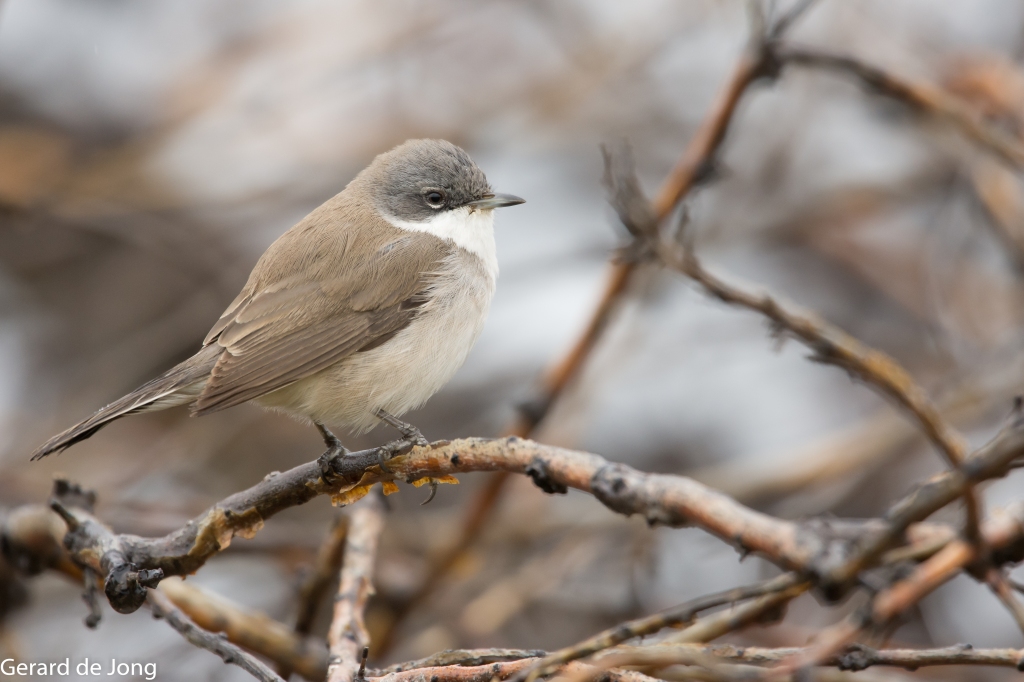
This is a follow-up to my last post, which reviews all of the literature regarding the taxonomy of the species. I haven’t given my opinion on whether I would lump or split the superspecies, and have merely tried to collate all of the information for you to make your own mind up. Regardless, if you haven’t read my last article, here it is, and here’s the map I made to refresh yourself on the distributions of the taxa:

I’m sure I’ll write an article in the future about the pros and cons of DNA vs morphology when it comes to lumps and splits, but it’s important to remember that what an individual Lesser Whitethroat sees and hears in another is impossible for us to comprehend. If an alien tried to distinguish between a Spaniard and an Italian, they would struggle to find any tangible differences using sonograms or comparing photos. However, a few sentences of (mis)communication makes identification easy for either ethnicity of the other. Of course, Spaniards and Italians are the same species, but you get my point. There has been a real shift away from use of DNA when it comes to taxonomy in favour of phenotypic or morphological traits, and while this makes it easier for the fieldworker, it doesn’t change the fact that the human gaze and ear can not accurately predict reproductive isolation or species status, nor can DNA.
That being said, where two Lesser Whitethroat taxa seem difficult to distinguish visually, the calls and songs they make are often distinct. Conversely, halimodendri and althaea have similar vocalisations but look completely different. In this blog post, I have compiled a host of photos which hopefully showcase the extent of variation in each subspecies as well as all of the song / call types I could find on xeno-canto.
While I was able to use many photos through asking for permission and creative commons licenses, some images I had to link instead, invariably from the Macaulay library.
This table I made below was used for any references to length or tail projection mentioned in the species accounts:

– t/w denotes tail to wing ratio (higher number means more tail projection)
– b/l means bill to length ratio (higher number means bill appears longer)
– bd/bl is the ratio between bill depth and bill length (higher number means bill appears heavier)
curruca – Lesser Whitethroat
The nominate race, curruca, has an earthy brown back, sometimes a greyish brown which fades neatly into a mid-to-light-grey nape and crown with the ear coverts slightly (but not always) darker. The flanks have a buff coloured, sometimes approaching pinkish wash, which contrasts the white throat, but not as significantly as will be seen in other taxa. The tail has distinctively little white, unlike many eastern races.
Compared to other races, curruca has a proportionally shorter tail and longer primary projection although most other biometrics are intermediate.
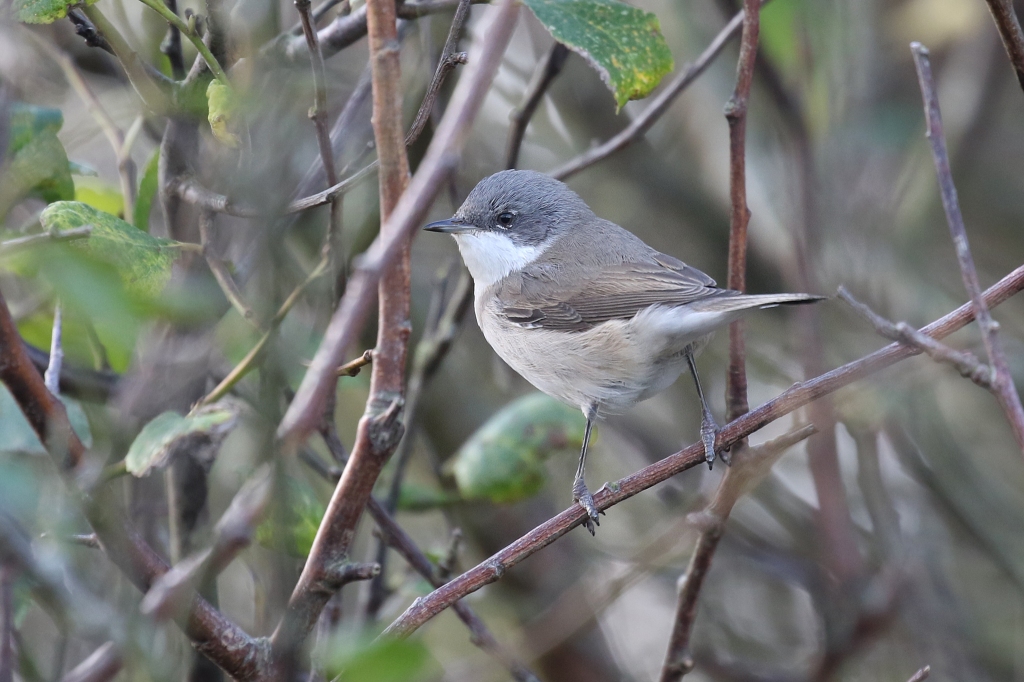


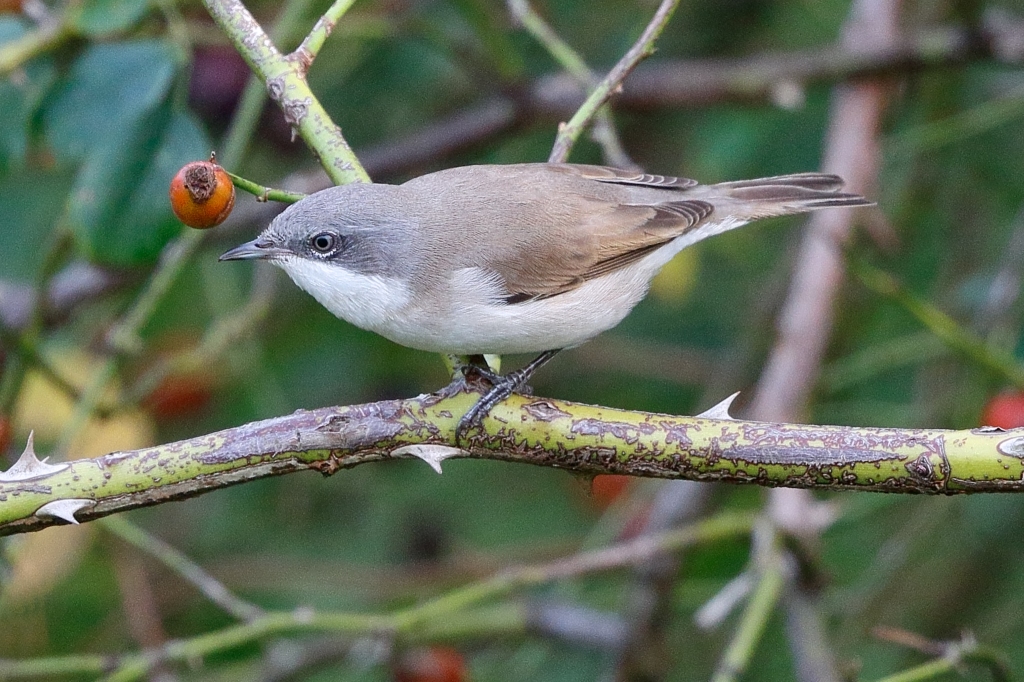
Vocalisations
The song of curruca is typically a very short, scratchy warble followed by its characteristic rattle.

Recording by Chie-Jen Jerome Ko in Belgium. XC316697.
While the length of the warble can vary, it almost always ends in a rattle.

Recording by Diego Fernandez Martinez in the Netherlands. XC797907.
The rattle can also be preceded by an extremely high-pitched call.

Recording by Simon Elliott, UK. XC725696.
Sometimes, newly arriving birds sing a subsong, which consists of long, drawn-out scratchy phrases. This individual occasionally breaks out into its typical rattle. The song is always rather jumpy. (Song starts after 8 seconds or so)

Recording by Alan Dalton, Sweden XC799384.
The call is a blackcap-like ‘Chek’. Very different from Eastern calls, as we will soon see. Shirihai also describes a wren-like rolling alarm call. I could not find such a call on xeno-canto, but one could be found for other subspecies. I personally have not heard curruca perform a wren-like call in England. If you have such a recording, please email me and I can edit this article accordingly.

Recording by Simon Elliott, UK. XC574103.
caucasica – ‘Caucasian Lesser Whitethroat’
Although considered by many to be a junior synonym of curruca, caucasica was shown to form a monophyletic clade, albeit nestled within the curruca clade. Biometrically, caucasica seems very similar to curruca, although I could find no data regarding body length. The tail seems proportionally longer than curruca although this seems trivial.
The race has a darker crown than curruca, reminiscent of althaea, with the flanks being a similar buff colour. The tail shows a similar lack of white to curruca.
I’m afraid I can’t get rights to use images from Macaulay directly on the blog but this link is a fantastic example of caucasica. The tail shows very little white, the bird looks dishevelled but the lack of contrast between the throat and underparts is still apparent. The back is a darker shade of brown than curruca, with more extensive dark grey from the head invading the mantle and scapulars. The ear coverts are not noticeably darker than the crown. The bird looks similar to althaea but note the lack of white in the tail as well as the brown wings.
However, this taxa is pretty variable. This bird from Georgia in June shows none of the features noted above, and looks inseparable from the nominate curruca. There seems to be considerable variation in this region. I would not recommend attempting to label anything as caucasica except within the treated breeding range, the status of this taxa remains dubious at best and considering it a junior synonym of curruca is reasonable.
Vocalisations
I found the vocalisations of caucasica to be very variable, much more-so than curruca. The first two songs have a far faster paced rattle (15/16 repeats per second) than typical curruca (9/10 repeats per second) and the rattle is one repeated note rather than two, reminiscent of the second half of wood warbler’s song:

Recording by Fernand Deroussen, Georgia. XC140056.

Recording by Franck Hidvegi, East Turkey. XC105689.
Whereas other songs are slower paced than curruca, with only 5/6 repeats per second yet two noted like curruca.

Recording by Lider Sinav, East Turkey. XC652828.
And others caucasica seem to be in-between. With a two-noted sounding song but the notes blur into each other, leading to upside down ”u’ or ‘v’ on the sonogram.

Recording by Fernand Deroussen, Georgia. XC139410.
The call sounds the same as curruca.

Recording by Albert Lastukhin, Georgia. XC193348.
To conclude, all the songs that I could find of caucasica were different from curruca. But all in completely different ways. There were a lack of recordings from the region but I couldn’t find any typical curruca rattles. This definitely needs more research and I would say that no caucasica can safely be identified both visually or through song outside of their breeding range.
althaea – Hume’s Whitethroat
‘Hume’s Whitethroat’ or Curruca (curruca) althaea is probably the most distinctive race. It is the longest race (along with margelanica) with the shortest tail in proportion to the body (not much shorter than curruca, but around 7% shorter than other Eastern races including margelanica). The bill is noticeably heavy.
The head is dark grey, the darkest of any race, and the ear coverts are hardly different in colour. The slate-grey head hardly contrasts with a dark grey-brown back. The underparts have a less warm hue, the whole bird having a cold-grey appearance. Finally, the outer tail feathers have extensive white, unlike the western races.


This bird seems lighter, but note that it is a light grey rather than brown. Once again, there is no contrast between the head and the back. The bird also has a blackcap type shape, rather than the more compact and petite shape typical of other Lesser Whitethroat taxa. Photo credits: Andy Warr, Rajasthan, India in January.


Vocalisations
Recordings of althaea were limited. I listened to all 41 recordings on xeno-canto and they didn’t seem to add up with written descriptions. All songs I could find were very short, basic, jumpy phrases, apart from a few recordings in NE Iran, which were longer warbles. For consistency, I only included recordings during summer months. The recordings from Iran were during April, I therefore didn’t include them as most taxa migrate through Iran in spring.
They mostly lacked the characteristic curruca rattle, some (such as the first recording) have short phrases reminiscent of the rattle, but the rattle is brief, slow and is not repeated every phrase.


Both recordings above by Ding Li Yong in different locations, Tajikistan. XC736118, XC733584.

Recording by Arend Wassink, Kazakhstan. XC150109.
The call is a distinctive wren-like trill. All sound files I reviewed were very similar, sometimes the call was integrated into song-like phrases too. No recordings had the typical curruca ‘tek’ call.

Recording by Oscar Campbell, Kyrgyzstan. XC494929.
blythi – ‘Siberian Whitethroat’
After reading the literature surrounding this subspecies, especially Votier and colleagues, I knew this would be hard. While blythi is clearly genetically and also ecologically distinct from other taxa, it is a nightmare to distinguish. I recall Votier and colleagues referring to ‘halimodendri-type’ blythi and ‘curruca-type’ blythi, and after pouring through photos, it is clear that this Siberian population is extremely variable.
Often wing formula is considered the key characteristic, which is completely impossible to view in the field and is hence useless in a guide of this type.
Siberian (Lesser) Whitethroat is often described as longer tailed and shorter winged than curruca. From the biometric data I could find, this is partly true but only by around 2%, less than other eastern subspecies. Sadly I couldn’t find any length data.
curruca-type Siberian birds
Most photos I could find from the UK of DNA tested individuals were halimodendri-type birds, this makes sense, because those that look like curruca wouldn’t have been flagged in the first place. However, images from Siberia paint a different story. Look at this bird identified as blythi from Irkutsk, Russia.
The back is a grey-brown, unlike the typical sandy brown of halimodendri, but not unlike curruca. However, the brown does appear to still extend onto the nape, which is rarely seen in curruca. The flanks are quite grey and cold, and the bird has a long appearance, like althaea but nothing like halimodendri. The primary projection is quite short and the tail appears pretty long. The ear coverts are also distinctly darker than the crown. The tail pattern is similar to that of curruca.
This bird from Novosibirsk, Russia, is very similar. The short primary projection and long tail are more obvious in this bird. But the cold grey washed underparts, grey-brown back and dark ear coverts are also notable on this bird. The outer tail feather on this bird is very similar to curruca but note the lack of white tips on the inner feathers.
I could find only 4 photos (of individual birds) online of this taxa, and all were on the Macaulay library, so I can’t post them here, only link them. Here are the other two photos for you to study:
This photo was taken in Kemerevo Oblast, Siberia. The back is a brown-grey and the ear coverts are slightly darker than the crown. The flanks are a cold grey.
This bird from Buryatia, Siberia has a distinctly cold-hued appearance. Note the cold grey underparts which contrast with the pure-white throat. The cap and upperparts look dark but not all can be seen from this angle. The bird also has a long jizz.
Photos of this taxa are quite hard to come by, but these photos show a bird very similar to curruca. The most obvious differences seem to be a grey wash to the underparts, rather than a warmer buff wash seen in curruca; shorter / blunter primaries which gives a longer tailed impression and possibly darker ear coverts.
halimodendri-type Siberian birds
There are a wealth of halimodendri-type photos online, typically from Western Europe where they are a frequent winter vagrant. An example bird is this one found at Spurn, UK in October.


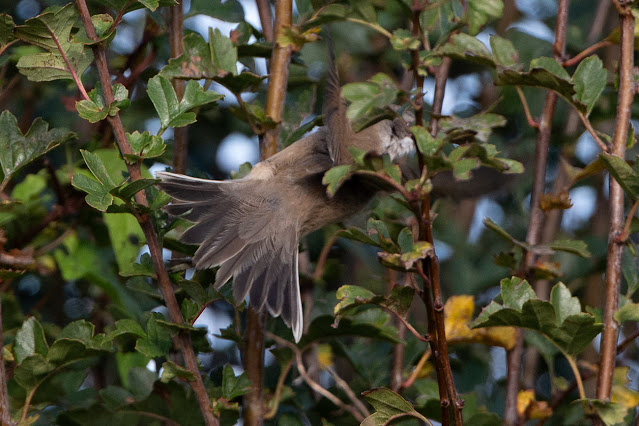
Photo credits for all three photos above: Andy Butler in the UK, October. Also check out Andy’s fantastic blog describing the bird here.
This bird, found in Kemerevo Oblast, Siberia in August shares many of these features, although the ear covert contrast is particularly apparent, reminiscent of margelanica (which will be treated soon) but note the thin bill and smaller appearance.
Vocalisations
The song seems very similar to curruca:

Recording by Alex Thomas, Siberia. XC432124.
The call of blythi is variable, but no birds I could find that were identified as blythi had the typical halimodendri-call. This bird from Finland (the bird was identified as blythi using DNA), had a typical curruca-like ‘tek’ as well as an althaea-like call.


Both recordings by Jarmo Pirhonen. XC307874 and XC307873.
Hence, morphology aside, a curruca-type bird that gives a wren-like rattle is likely a blythi. Whereas a halimodendri-type bird that gives either a wren-like trill or a curruca-like ‘tek’ without any tit-like vocalisations (see halimodendri) should be studied well, as it may be a blythi.
To conclude, identification of blythi is not impossible. A mixture of morphological and vocal features can identify both halimodendri-type and curruca-type birds, but care must be taken.
halimodendri – ‘Turkestan Whitethroat’
C. (curruca) halimodendri is a distinctly small taxa, along with minula, approaching Willow warbler size. The tail is proportionally long, 2% longer than blythi and almost 5% longer than curruca. This creates a short-winged and long-tailed impression, along with a smaller impression compared with curruca. While it is best recognised by its distinctive tit-like call, I would argue that it is also quite straight forward to separate it visually as well.
The back is sandier than other taxa, with the brown extending up the nape, as seen in halimodenri-type blythi. The head is pale grey, sometimes the same colour as the upperparts with variable contrast between the ear coverts and crown. The ear coverts are also often brown. The flanks are a sandy buff colour, sometimes not much lighter than the back, which contrasts with the almost pure white throat. I have often seen reference to a short bill, but the data from HBWPB suggests that their bill is the same length (if not slightly longer) as other taxa when compared to body size. The tail feathers also show far more white than curruca.



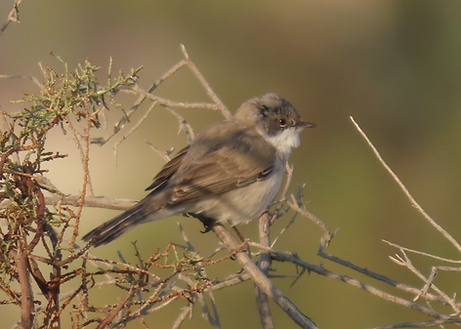
This bird has the typical dusty brown coloured upperparts, with brown ear coverts. The outer tail feather shown has striking white, unlike in blythi and curruca. This bird also has a very long-tailed look.
Worth noting is this bird which appears different to all other birds treated above. It was trapped and ringed at Spurn and the Ebird checklist claims it was confirmed halimodendri by DNA analysis. The upperparts are the right colour, very similar to the birds above. The ear coverts appear very dark, which shows the variability and the outer tail feathers are almost fully white. All of the characteristics above are in line with the other examples of halimodendri. However, the jizz of this bird appears different. This bird has a larger appearance and the tail doesn’t look as long as the birds above, I’d be intrigued to see the measurements of the bird.
One intriguing factor that should be kept in mind is clade 2b. Olsson and colleagues showed that halimodendri is made up of two distinct clades, 2a, which were sampled from Kazakhstan as well as 2b which was only found on wintering grounds and passage (apart from the mystery Chinese bird within margelanica‘s range). The breeding range of clade 2b is hence a complete mystery. Even more confusingly, this paper claims that the majority of vagrant halimodendri birds found in Britain fall in clade 2b. Perhaps this means that its range is closer to Europe, Astrakhan perhaps?
I couldn’t find any information regarding which particular birds fell into which clade, the only 2a was reportedly from Aberdeen in 2004 but annoyingly I couldn’t find any photos online. Perhaps the variability shown above can be explained by differences between 2a and 2b. An obvious first step would be finding the breeding range of 2b in order to compare them, which is easier said than done. More information on the taxonomy of halimodendri‘s clades 2a and 2b can be found at my last blog post.
Vocalisations
The song of halimodendri seems very similar to althaea.

Recording by Manuel Schweizer in Kazakhstan. XC328536.
This song below appears a lot more varied and dynamic than althaea is typically, although the song above does not.

Recording by Albert Lastukhin in Kazakhstan. XC184736.
The easiest feature of halimodendri isn’t its appearance or song, it’s its call. A tit-like harsh grating call appears to be unique to the taxa. Some sources from the middle-east claim that curruca can utter the call as well. However, I could find no such evidence. I listened to over 200 recordings of calls of curruca from Europe and found no such calls.
In Western Europe the call is frequently considered an important sign of halimodendri and as far as I’m aware, I have no knowledge or experience of a tit-like call in curruca, the subspecies that I’m familiar with. Those calls from the UK on xeno-canto that are tit-like all have captions which state that the bird was confirmed halimodendri. I would therefore suggest that the following call is a reliable characteristic unique to halimodendri:

Recording by Oscar Campbell in Kazakhstan. XC378942.

Recording by Thijs Fijen in Kazakhstan. XC145277.
Eastern Lesser Whitethroats – a dilemma
A week of work was spent trying to write accounts for margelanica and minula. The approach I took with all taxa in this post was to find photos of either birds on confirmed breeding grounds or birds away from breeding grounds which had been identified using DNA analysis (an exception was made for the very distinctive althaea). I then took notes on these photos and compared my findings to existing literature. This approach meant that I wasn’t regurgitating already existing information, and I hope this is apparent in my writing.
This approach was particularly useful for blythi. As previously mentioned, blythi is probably the most variable taxa, with large grey birds reminiscent of althaea and birds very similar to curruca as well as halimodendri. In Europe and wintering grounds, all records of blythi are biased towards halimodendri-type birds, because those that look more like curruca aren’t flagged. If I were to use wintering birds as my examples, the true extent of variation would be ignored and it would feel disingenuous. Only through looking at breeding, summer range birds can the diversity of these taxa be appreciated. Diversity is not shown on wintering grounds because those that aren’t ‘archetypical birds’ are mostly either left unidentified or misidentified.
The Eastern taxa breed in areas where there is not much coverage from photographers. They are typically poorly understood, the ranges are poorly demarcated and there are likely both blythi and halimodendri ‘imposters’ among them belonging to clades 1b and 2b which may or may not appear more like the eastern taxa than their closest relatives (blythi and halimodendri respectively).
Minula was previously thought to extend into Central Asia, hence, many records from the Middle East and other wintering or passage grounds simply appear to be misidentified halimodendri. This is because many field guides, particularly those written before Olsson and colleague’s paper, often synonymised halimodendri and minula or considered halimodendri to be a slightly darker taxa, likely now accounted for by variation within halimodendri. C. minula is now thought to winter in Pakistan and India, so all records from elsewhere should be taken with a handful of salt.
Sorting by images from Xinjiang doesn’t make things easier either as minula only seems to breed around the Tarim basin, while margelanica breeds in E, NE and N Xinjiang and halimodendri probably breeds near the Kazakh border too. Almost all of the images of ‘Lesser Whitethroats’ from Xinjiang were therefore not minula (at least don’t appear to be minula). Shirihai and Svensson seemed to have a hard time too, in a book where almost all photos are outstanding, the images of minula are grainy, blurry record shots.
Until more information comes out of the region, I am hesitant to label anything from wintering images in India, especially with two unknown taxa flitting around. Thus, accounting for uncertainty of breeding ranges and a lack of images from China, I found a whopping 1 image of minula which could be used. Considering the huge variation seen in all other taxa, it would be myopic to consider this one photo enough for a photo ID guide.
Photos were more abundant of margelanica, although writing an account for margelanica without one for minula seems useless as far as ID would go. It would be like a Scottish Crossbill ID guide without mentioning Parrot Crossbill. Below are short accounts of the two taxa, but please appreciate that both likely vary markedly more than can be shown with these few images.
minula – Desert Whitethroat
‘Desert Lesser Whitethroat’ or C. (curruca) minula is the smallest of the Lesser Whitethroat complex, even smaller than halimodendri. It has one of the longer tails in proportion to its body, very short primary projection and the thinnest bill. While the length of the bill in proportion to body length is no different from other taxa, minula has the smallest bill depth, giving a delicate look.
This taxa is hard to separate from halimodendri, with similar biometrics and similar plumage. The brown from the back extends onto the nape, as in halimodendri and blythi, although the back appears almost ginger in some birds. The head is a light grey with the ear coverts not showing particularly marked contrast with the crown, often with streaks of brown, as in halimodendri. The outer tail feathers are white.

margelanica – Gansu Whitethroat
‘Gansu Lesser Whitethroat’ or C. (curruca / minula) margelanica is the longest taxa with the longest tail projection and thickest bill. The proportions are reminiscent of althaea but margelanica has a far longer tail projection and an entirely different colour.
The plumage is similar to minula (although the bird is clearly larger). The thick, stout bill is also separable from the thin bill seen in minula. Shirihai and Svensson describe a ‘penduline-tit like mask’, and some images from Qinghai on the Macaulay library show this striking feature (link).
The flanks are a rich buff colour, which at times don’t appear to contrast much with the upperparts, like minula. Where scale is hard to gather from a photo, it can be hard to discern from minula, although this should be easier in the field.
The link above shows a bird which exhibits all these features noted above, especially the mask.
On this blog post from birding Mongolia, scroll down and you’ll find two ringed, DNA analysed photos of margelanica. The ear coverts are distinctively dark, the bird has a very large, long appearance. The upperparts are a rich ochraceous colour with the flanks a similar but lighter colour which contrasts with the throat. The primary projection seems quite long, as does the tail.
Conclusions & 4 challenges to test yourself
While the taxa are all very variable and have some overlap, a bird which affords good views and is vocal should be identifiable. Most photos from wintering birds in the Middle East can be identified, some are trickier, but vocalisations should clinch ID. South Asia is a different story, with blythi, margelanica, minula, althaea, telengitica which are likely a junior synonym of margelanica but nonetheless regarded as morphologically distinct, clade 1b and probably 2b as well. Either DNA analysis with images of wintering birds or better documentation of breeding ranges in Asia is needed before identification can be approached.
When I first posted my original article on twitter, Howard King replied with 4 images of Lesser Whitethroat. I am unsure as to whether he has identified them already, regardless, I thought they would present a good exercise after this hefty article.

Colouration: the bird is a sandy, dusty brown/grey with very little contrast between the head and upper parts. The lower parts are a peach colour, with the throat a white colour.
Identification: halimodendri seems a safe bet based upon the colouration and proportions.
The back and underparts do not seem rufous enough for minula and the head seems too light, although, once again, be mindful of the lack of variation understood in minula. The location of Bahrain also adds up with halimodendri‘s understood wintering grounds.
This taxa is known to be quite vocal on wintering grounds, so a tit-like call would seal ID.

Colouration: The bird is a cold dusty grey colour, similar to the bird above but the underparts are cold. There is little contrast in the upperparts, ear coverts or crown.
Identification: althaea is a good bet, ticking all the correct boxes, very similar to the second image on the species accounts.

Proportions: The tail is long, primary projection is hard to see. The bird looks intermediate size with a relatively long, heavy beak.
Colouration: The bird is a sandy brown, with brown extending up the nape. The ear coverts contrast a lot with the grey head, although the crown and nape don’t contrast too much. The underparts are a warm light peachy colour and don’t contrast too much with the back.
Identification: This one is trickier. The nape and colouration suggest halimodendri and the ear coverts are darker than typical but within the variation seen within the taxa. Blythi is possible given the bird has a slightly larger jizz and ear coverts of that colour are more common in blythi than a typical halimodendri. Views of the tail and vocalisations would be needed for a positive ID of this bird, although I will tentatively label it a halimodendri.

Colouration: The upperparts are a grey-brown with underparts that don’t contrast much with the white throat. The crown is grey, and the nape seems grey from this angle. The ear coverts are darker than the crown. The underparts contrast little with the throat and are a very light buff wash.
Identification: Looks good for curruca for me with intermediate proportions and a brown-grey upperparts. Vocalisations would be nice to seal this ID, but I have no reason to believe its not curruca.
All photos above by Howard King.
References
Handbook of Western Palearctic Birds. Shirihai and Svensson, 2018.
Advanced Bird ID Guide. Nils van Duivendijk, 2010.
Saudi Birding – a great article on halimodendri ID
Andy Butler Diaries – a thorough write up, featuring notes on a blythi found in the UK
Bird Guides – pictures and notes on a halimodendri found in the UK
Leave a comment